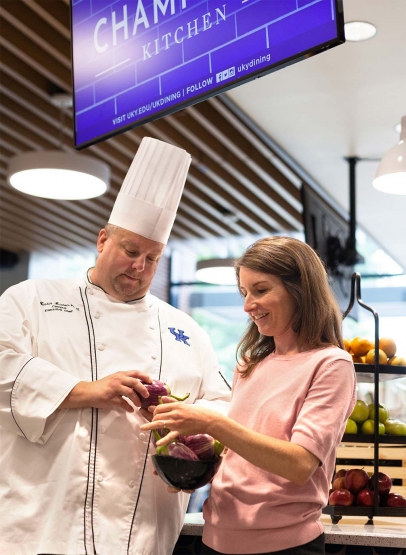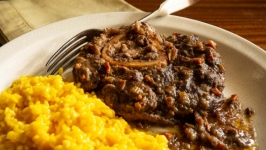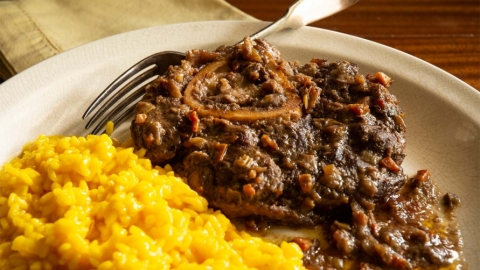Local Food Scores Big at University of Kentucky
When students started classes at the University of Kentucky on August 26, more than 7,500 of them used their meal plan vouchers to buy lunch at the two dining halls: Champions and Fresh Food Company. At the salad bar, they could have chosen among spring mix, pea shoots, cucumbers, multicolored peppers, multicolored heirloom cherry tomatoes, beets, carrots and red onions.
At the “comfort food” station at Champions, the students could choose between smoked brisket or herbed pork loin — actually, they could have had both; the dining halls are an open-choice buffet. At the pizza station they could have chosen slices with several toppings. At the kiosk “Pasture,” some students might have opted for the Pasture Burger, made with grassfed beef, the regular Monday lunch offering.
The pork and the beef used in these dishes and virtually all others at the university were produced by 25 of what any average person might call “small family farms” in (mostly) Central Kentucky. The produce for the salad bar, too, was grown on six family farms not far from Lexington. Pizza sauce was made by a Louisville food processor with tomatoes grown in Hart County. The products are grown on farms too big to depend on farmers’ markets for their only income, yet too small to make a living in typical high-volume markets.
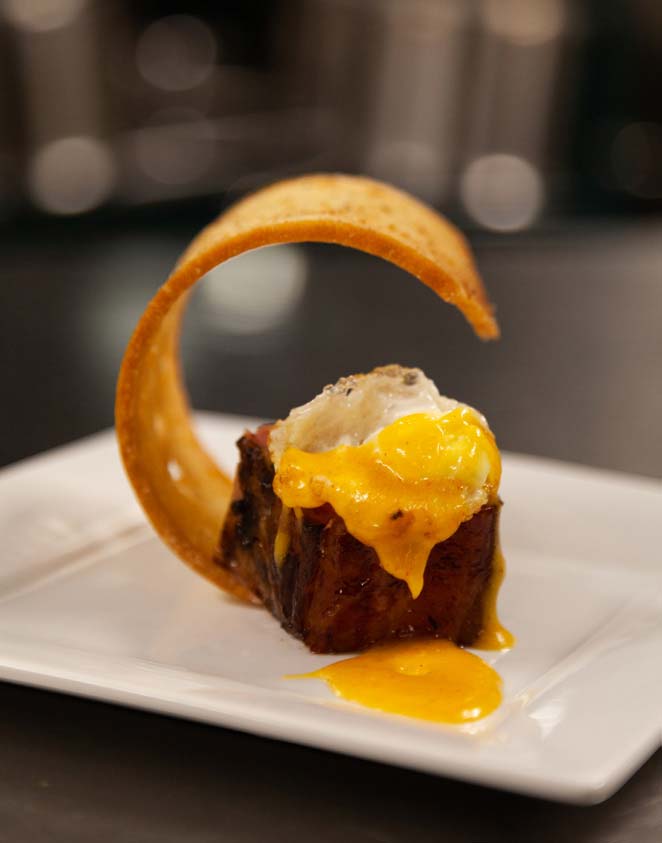
“Bacon and Eggs.” Slow Smoked Marksbury Farm Pork Belly topped with a Quail Egg and Chipotle Hollandaise Served on a Baguette Tuile.

Marksbury Farm’s restaurant Pasture prepares their signature grass-finished burger for UK students at the Champions Kitchen grill station. In the background is a pastured pork chorizo patty with provolone, lime crema, cilantro and pickled red onion.
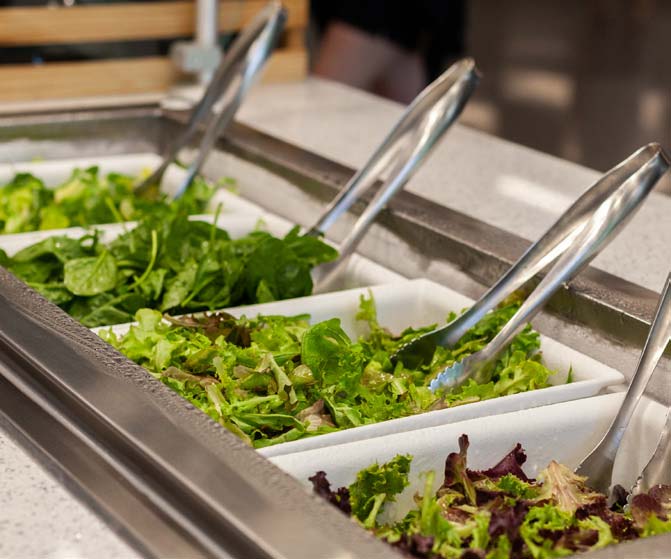
The Local Salad Bar sources greens from a variety of local farms: Salad Days, Elmwood Stock Farm, Crooked Row, Mount Pleasant Acres, and Courtney Farms.
The commitment that the university’s dining service has made to these farmers and others has led to opportunity, stability, innovation and a strengthening of Kentucky agriculture and food systems. The purchase commitment and system solutions serve as a national model.
More important, the commitment to purchase local has demonstrated that significant change can happen within a previously impenetrable purchase-and-delivery system on which institutional business models depend. To maximize profits, institutions use low-cost, high-volume, standardized goods; large national vendor contracts; rebate reward systems for purchases; complicated data systems and universal menus.
The UK dining contract was the most important part of the groundbreaking change that has happened in Lexington, and without input from the community it might not have happened.
In 2014, the university signed a 15-year contract with Aramark, a multinational service provider, to take over campus dining services. Aramark brought surge of growth to the university, providing capital to build and renovate dining halls, add classrooms, offices and programming, along with other benefits.
During contract negotiations, there was a lively and public debate about priorities, when citizens, students and faculty expressed concerns about including university support of agriculture and agricultural education.
When negotiations were completed, Aramark had committed $245 million worth of construction, renovation and commissions to UK. In addition, Aramark committed to buying $2 million worth of “local food” and local food-business products, pledging a 5% increase each year. Financial penalties were built into the contract should Aramark fall short.
In the last two decades, much work has been done by many people in Kentucky to increase availability of local food to chefs, schools and consumers. Until 2014, institutions had not been involved in local buying.
The University of Kentucky and Aramark changed that. But change has not come easily, and the learning curve has been steep.
The first challenge: defining “local food” and “local-food business.”
Initially, the contract defined “local” as either a product deemed Kentucky Proud by the Kentucky Department of Agriculture, or a food produced within Fayette or the six contiguous counties. One year into the contract, it was revealed that $1 million of the local commitment was spent on Coca-Cola, which has a Fayette County bottling plant. Other “local” expenditures included Pepsi and Ale-8, ice, doughnuts and so on.
“Foes object when University of Kentucky vendor meets in-state food-buying goal with Coca-Cola, ice,” ran the Herald-Leader newspaper’s headline (full disclosure: the author was quoted in that story).
While university officials publicly commented that the contract obligations had indeed been met, the community was not mollified. “The intention [of the contract] was to increase sales for local farmers and to promote local food,” Lexington nutritionist Anita Courtney told the Herald-Leader at that time. “It doesn’t do any of that.”
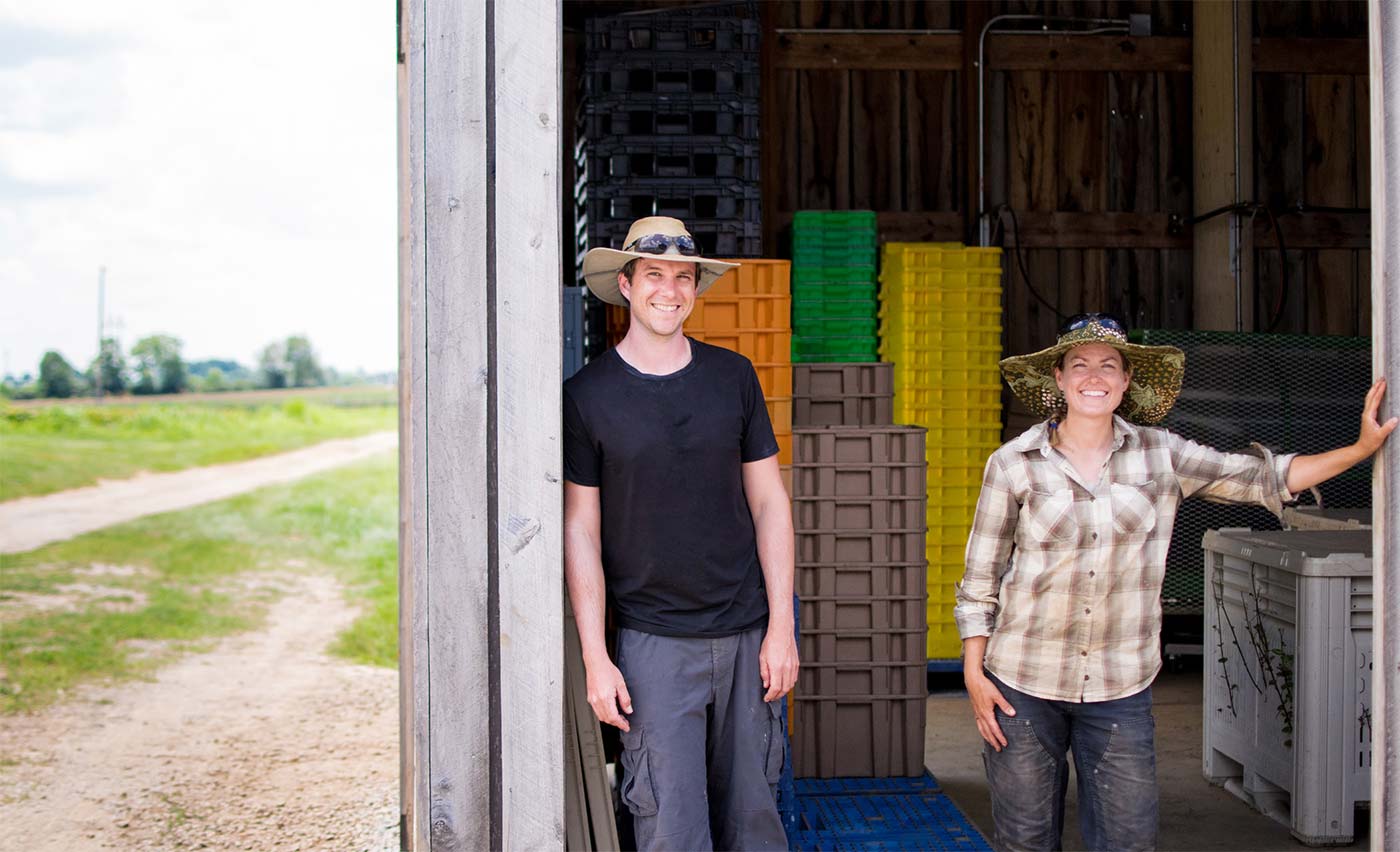 Neil Wilson and Kristi Durban at UK’s South Farm where they educate students on organic horticulture and supply produce to UK Dining when they have surplus from their CSA. Photo: Sarah Caton.
Neil Wilson and Kristi Durban at UK’s South Farm where they educate students on organic horticulture and supply produce to UK Dining when they have surplus from their CSA. Photo: Sarah Caton.
The university administration and Aramark officials began discussions to rectify the mistakes. By 2017, contract language had changed, specifying a dollar amount spent on product “with some portion … traceable to a Kentucky farm,” said Lilian Brislen, executive director of the UK Food Connection, a research and educational center that evaluates Aramark food expenditures each year. That number was $652,997. There were also requirements for spending on food-related Kentucky businesses, owned by Kentuckians and located in Kentucky, with a target of $1,648,193.
That’s when the transformation of institutional dining at the University of Kentucky began.
Institutional dining services everywhere operate by a set of universal business practices that prevent managers from buying outside of prescribed product lists. National contracts establish suppliers for Aramark accounts nationwide. These suppliers issue rebates to Aramark based on volume purchases. Distributors—the people who drive the food to the kitchen—also have contracts with national suppliers. Purchase requirements along with data and accounting systems are set up for these products. Recipes are the same at every venue and use the products being distributed nationwide.
If a farmer shows up with short ribs at the back door of Champions kitchen, there is literally no way for Chef Chris Spera to buy her beef. Yet Aramark’s contract with UK required that they do so.
The heavy lifting of change fell to Carolyn Gahn, a recent hire as Sustainability Director for Aramark in 2017. At the time, dining services depended on “value-added” sproducts—prepared items, like a three-bean vegan chili with local vegetables made by Louisville company Custom Food Solutions (CFS)—to fill their local slots. These items “were made to accommodate the way our ordering system and menu planning worked,” said Gahn.
CFS products accounted for maybe 25,000 pounds of Kentucky produce.
That amount of produce didn’t begin to meet the requirements of the contract.
“The main area for growth in our purchasing was fresh meat and produce,” said Gahn. “That was my goal, to increase the spend in those two areas, knowing it has the most tangible impact on farmers and the spend could be increased each year.”
After spending time with Executive Chef Martin Burton and his team and learning the process of ordering, receiving and inventory, Gahn set to work. She needed to identify products that would work within the system.
“My mantra was ‘I don’t want to be the only customer,’” Gahn said. Being a sole buyer has several drawbacks. The buyer may be required to “buy an entire pallet at one time, or it might mean the items are not stocked with distributors, or a higher price point,” she said.
Sole buyers are a risk to the farmer and local business, too. If any seller depended entirely on UK dining for their livelihood, a change in buying practices could ruin them.
Spreading risk to several farmers led Gahn to Marksbury Farm Market, a multifaceted food business near Danville based on a meat processing plant. Marksbury buys grassfed beef and pasture-raised chicken, lamb and pork from Kentucky farmers. Because Marksbury was an established business, and because it purchased from many farmers and sold to many sales outlets, no one person bore the entire risk.
Then the hurdles started. Expense, delivery, even the particular cuts of meat had to be streamlined. Gahn maintained that purchasing whole animals was the only viable solution.
The products are grown on farms too big to depend on farmers’ markets for their only income, yet too small to make a living in typical high-volume markets.
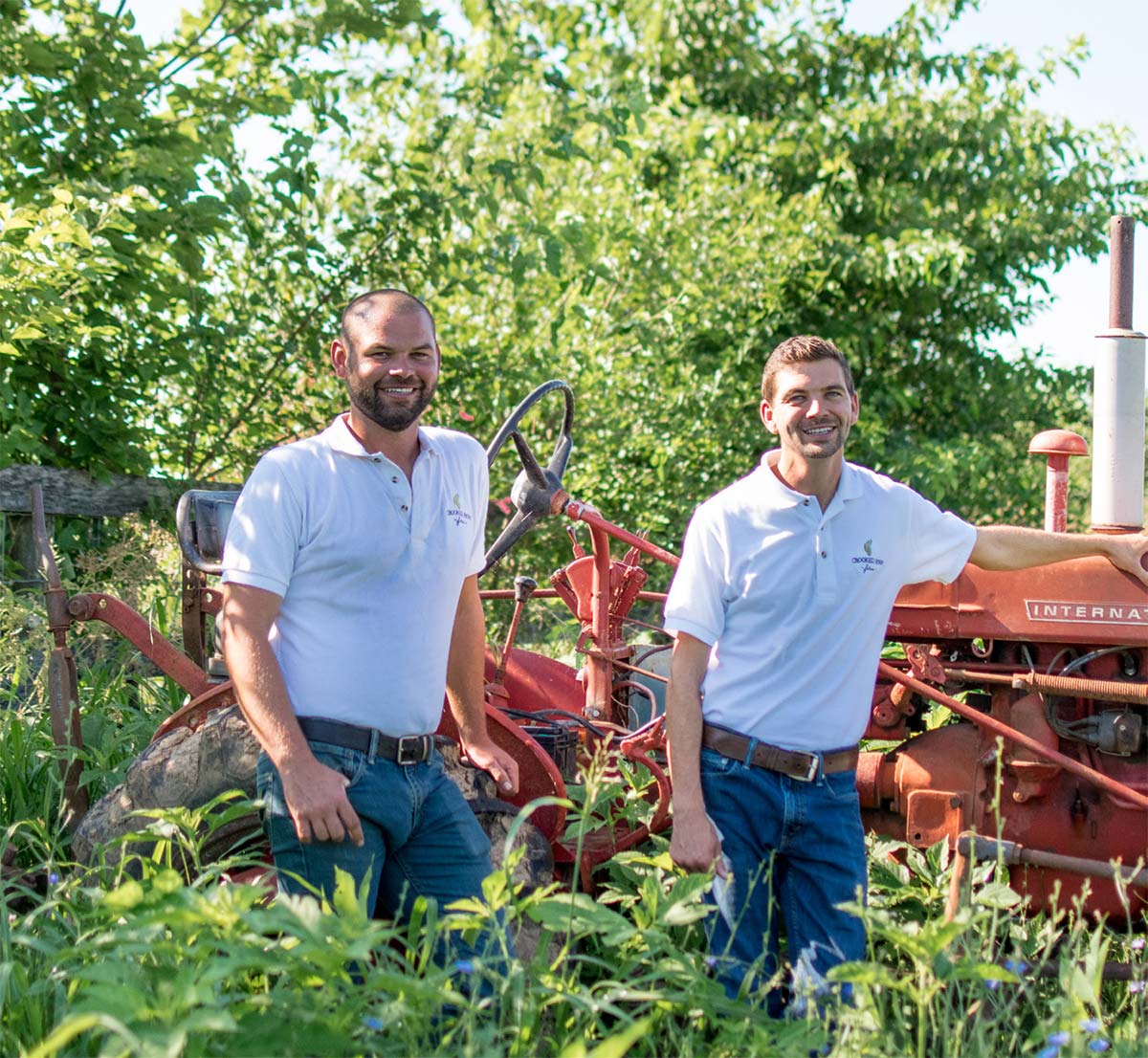
Crooked Row’s Thomas Sargent and Robert Eversole, third generation farmers, standing by their cultivating tractor.
Preston Correll, a founding partner of Marksbury, was skeptical. He’d seen enthusiasm for whole animals wane when reality set in. Chefs get excited when the cost of meat is averaged over the entire animal, said Correll. They think they are getting tenderloin at the same price as the hamburger. But there are costs not factored in, like bones. Once an accountant gets a look at the numbers, Correll said, whole-animal programs usually fade.
But Gahn was stubborn. “Purchasing the whole animal was the only option for me,” she said. “From an operations standpoint it doesn’t make sense to purchase a la carte.” One complicating factor: Aramark can’t purchase meat based on an “average” carcass price—they have to know what each plate of food cost Aramark to serve. Knowing “plate cost” is essential to Aramark’s business plan.
One solution: putting different cuts of meat in boxes based on how they should be cooked, like “braise” or “roast” or “smoke.” Short ribs, shanks and shoulder go into the braise box; roasts were top round, sirloin and pork loin. Five different box types reduced inventory headaches at the distributor. Rather than having to account for baby back ribs, spare ribs, country ribs, pork loin, pork tenderloin, shanks, hams, shoulder and so on, there were just five slots for the boxes of meat.
As this purchasing method is perfected (and it isn’t yet), easy communication between chefs, Gahn and Marksbury makes it easy to make changes in real time. “I underestimated [Aramark’s] commitment to the local program and the effort they brought to bear to make it work,” said Correll.
The commitment and the volume make a substantial difference to his business, and to the Kentucky farmers they work with. “It’s really significant volume. It’s several head a week of both beef and hogs — it allows us to contract with farmers a whole lot more confidently,” said Correll. Farmers get premium-priced commitments from Marksbury, a benefit over relying on market prices at an auction. Aramark’s commitment “is a major component in those families being able to decide to farm or not farm, because of the extra income and the stability,” Correll said.
Similarly, Gahn worked with the Local Food Connection (LFC), a produce buyer and distributor that has worked since 2015 with Kentucky and Southern Ohio farmers. The LFC deals only with local farmers and, until its relationship with UK, had sold mainly to chefs and retailers.
Seasonal limitations to produce are a major barrier to local purchasing. Colleges operate from mid-August to early June—only one or two months of prime growing season. Local Food Connection founder Alice Chalmers had been working for years with her farmer suppliers to extend the growing season into winter.
Gahn identified the salad bar as a station that could adapt to produce changes week to week. While winter is challenging, salad greens can grow without the heat or light required by, say, tomatoes or corn. Roasted root vegetables can be offered in winter.
Chalmers worked with Gahn, UK personnel and others to train and certify six farmers on food safety measures. All parties agreed as to what and how much each farmer would grow throughout the school year. Aramark committed to purchasing 24,000 pounds of produce from the Local Food Connection.
That pre-order included radishes — 122 pounds of radishes per week, which turned out to be way too much. “On paper we looked at it and didn’t think about it,” said Aramark Chef Danielle Gallaway. “We got creative: We pickled some, we roasted them.” Roasted radishes were not the answer.
But the system worked the way it should: While the chefs were getting creative with recipes, the Local Food Connection found more restaurant buyers and the farmers were mining their own outlets while reducing the number of radishes they grew. The risk was spread out; no one was irrevocably harmed.
Aramark’s “willingness to pilot [the salad bar] at UK is huge,” said LFC owner Chalmers. “It’s now been used as a model for other institutions, like University of Louisville.”
Receiving oxtails and short ribs in the braise box requires some freelance decision making that may take chefs outside the bounds of corporate recipes. In that case, the staff will work with the staff dietician to put the unsanctioned cuts into recipes that supply similar nutrition — eye of round is a suitable substitute for top round, for instance.
The Kentucky food/Kentucky business commitment has predictably led to more stability and/or income for farmers and businesses. But it has had less predictable but equally important ripple effects.
“The thing that makes me proud of our work is less about the dollars and more about the changes in perception and mind-set with everyone involved,” she said. As an example, she said, having the flexibility to buy products that have some but not all Kentucky ingredients, UK dining significantly increases farmer benefit. Processor Custom Food Solutions uses Kentucky produce in its marinara sauce, which starts with a base of California tomato paste; Weisenberger cupcake mix includes Kentucky flour along with conventional sugar and baking powder.
Gahn measures her success in part by the quality of the food served. Campus chefs, using beef shank to make osso buco and lamb shoulder to make schwarma, elevate the dining options. Lexington restaurants subcontracted to provide food in the dining hall include Athenian Grill, Pasture and Atomic Ramen (which uses bones to make broth), broadening students’ exposure to international flavors.
“The challenge with local food is trying to make people care about [it],” said Gahn. “What happened last year is that we changed palates. [The students] know what good food is.”
Last year’s purchases exceeded goals and expectations. Expenditures on local food and food business items was $2,624,573, or 146% of the required minimum. Of that, foods that had at least 10% farm product in them accounted for $1,327,922, or almost double the required minimum, according to a report released last month by the UK Food Connection.
With more meal plans purchased this year, with athletic dining participating and with the salad bar ingredients produced through the challenging late-winter season, Gahn predicts sales will grow. Virtually all beef, pork and lamb — and much of the fish — served on campus comes from Kentucky producers.
Brislen said that success is about more than numbers. “We’re asking a lot of our dining partner. This is not business as usual, that’s the whole point: It’s business as unusual. All this learning and innovation, the growth along the way, it’s not about getting across the finish line every year. We’re in a place where year over year, we look at how do we develop those connections that create a robust local food economy.”
UNIVERSITY OF LOUISVILLE DINING SERVICES COMMITTED TO SOURCING LOCAL
Other Aramark schools, Eastern and Western Kemtucky University and the University of Louisville have provisions for local in their dining contracts. In 2018, the University of Louisville spent $42,131.25 on local produce, some of that coming through the same salad bar program used at the University of Kentucky. UofL spent $73,425.23 on local (not including dairy) and $159,471.23 on animal products. Read more about University of Louisville’s efforts here: https://louisville.edu/sustainability/operations/food/#campus-dining


